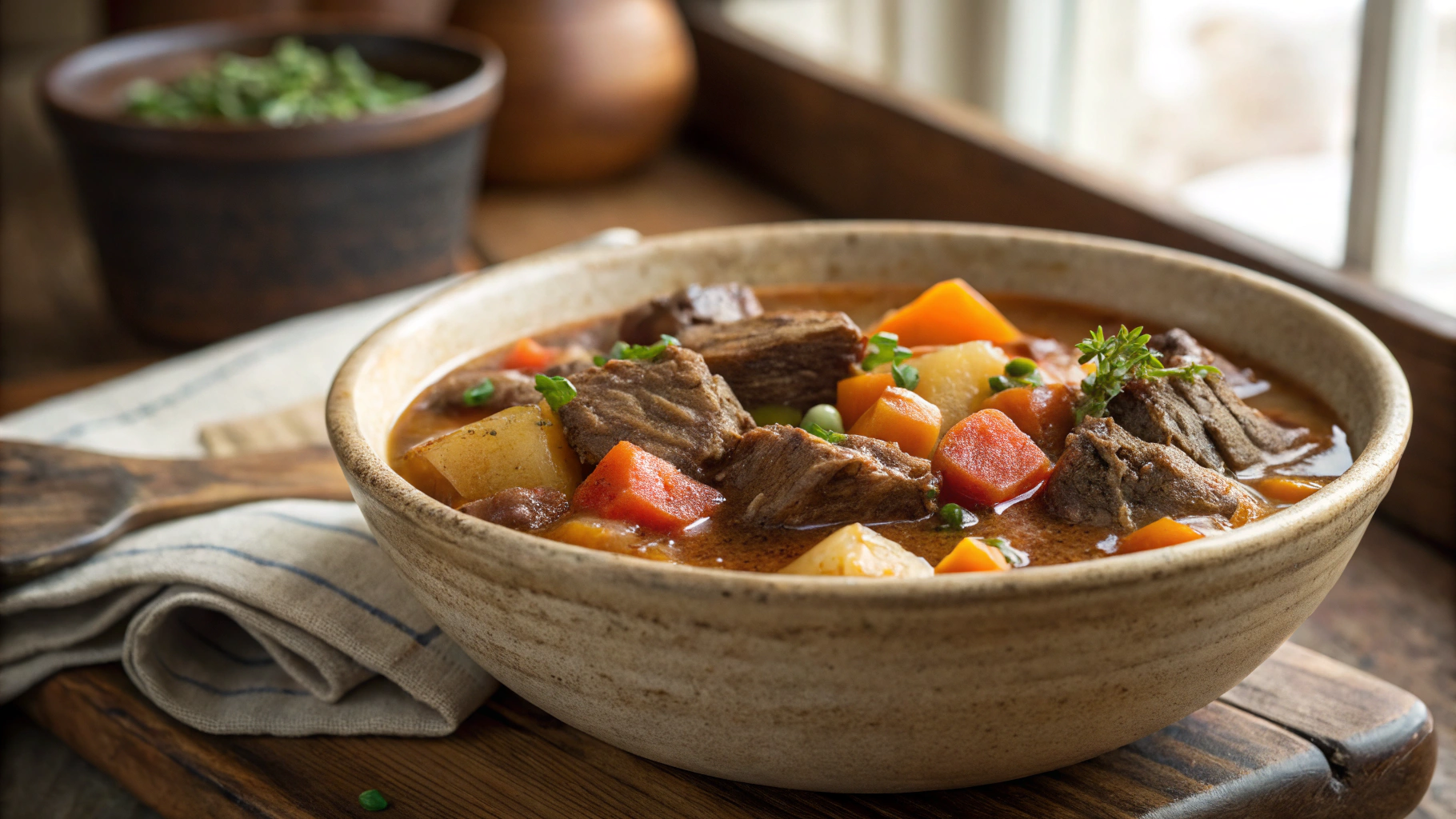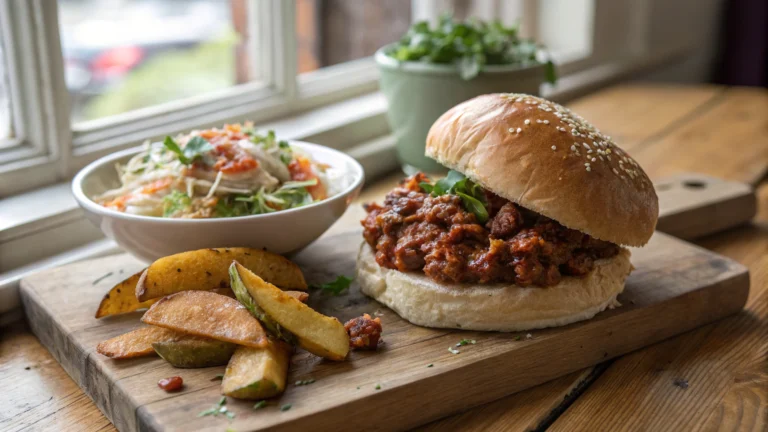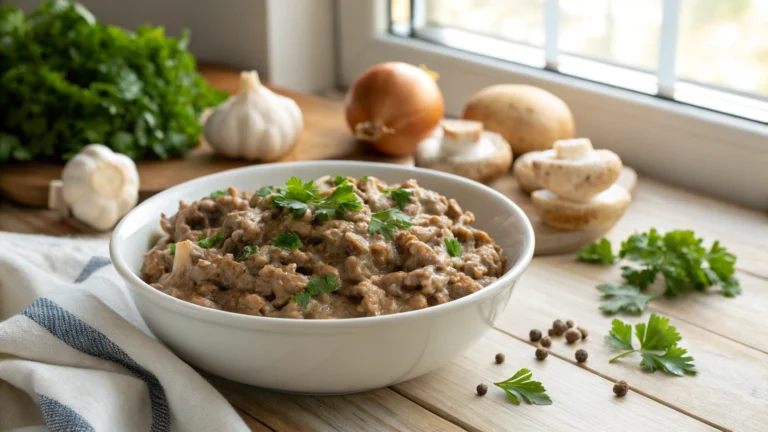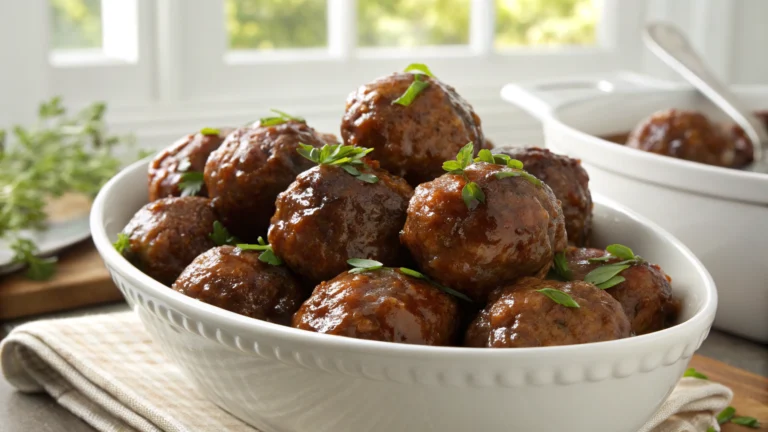Old Fashioned Beef Stew Recipe
Serving Old-Fashioned Beef Stew
Once your Old-Fashioned Beef Stew is ready, serve it hot in bowls with a side of crusty bread or over a bed of mashed potatoes for a hearty meal that will warm you from the inside out. Garnish with fresh parsley for a pop of color and a sprinkle of black pepper for an extra kick of flavor. Enjoy this timeless classic with your loved ones and savor every comforting spoonful.
Health Benefits of Old Fashioned Beef Stew Recipe
Old-fashioned beef stew is not only a comforting and hearty meal but also packed with nutritional benefits. The combination of tender beef, nutrient-rich vegetables, and flavorful herbs creates a dish that is not only delicious but also good for your health.
Beef is an excellent source of high-quality protein, essential for muscle growth and repair. It also provides important nutrients like iron, zinc, and B vitamins that support overall health.
The vegetables in the stew, such as carrots, potatoes, and celery, are rich in vitamins, minerals, and dietary fiber. These nutrients help support digestion, boost immunity, and contribute to overall well-being.
The slow cooking process of the stew helps retain the nutrients in the ingredients, ensuring that you get the maximum health benefits with every spoonful.
Origin and History of the Old Fashioned Beef Stew Recipe
The origins of old-fashioned beef stew can be traced back to traditional European peasant dishes that were made with simple and readily available ingredients. Over time, beef stew recipes evolved and adapted to different regional tastes and preferences.
In the United States, beef stew became a popular comfort food during the early 20th century, especially during the Great Depression when economical and filling meals were in high demand. The stew’s versatility and ability to feed a large number of people made it a staple in many households.
Today, old-fashioned beef stew continues to be a beloved classic, enjoyed by families around the world for its hearty flavors and nostalgic appeal.
Delicious Variations Around Old Fashioned Beef Stew Recipe
While the traditional old-fashioned beef stew recipe is a timeless favorite, there are various delicious variations that you can explore to add a unique twist to this classic dish.
One popular variation is adding a splash of red wine to the stew for a richer and more complex flavor profile. The wine adds depth and sophistication to the dish, making it perfect for special occasions or dinner parties.
Another tasty variation is incorporating different herbs and spices, such as rosemary, thyme, or smoked paprika, to enhance the overall taste of the stew. Experimenting with seasonings can take your beef stew to the next level of culinary perfection.
For a lighter and healthier version, you can opt to use lean cuts of beef and load up on a variety of colorful vegetables like bell peppers, zucchini, or sweet potatoes. This variation adds more nutrients and freshness to the stew without compromising on flavor.
Chef’s Tips for Perfecting Your Old Fashioned Beef Stew Recipe
Mastering the art of making old-fashioned beef stew requires attention to detail and a few expert tips to ensure that your dish turns out perfectly every time.
1. Choose the right cut of beef: Opt for marbled cuts like chuck roast or brisket that are ideal for slow cooking and develop rich flavors as they simmer.
2. Sear the meat properly: Browning the beef before simmering enhances the depth of flavor in the stew and creates a caramelized crust that adds complexity to the dish.
3. Layer the flavors: Building layers of flavor by sautéing aromatics like garlic and tomato paste before adding liquids enhances the overall taste of the stew.
4. Don’t rush the cooking process: Allow the stew to simmer low and slow to tenderize the meat and allow the flavors to meld together harmoniously.
5. Taste and adjust seasonings: Regularly taste the stew as it cooks and adjust the seasonings to ensure a perfectly balanced and delicious end result.
rowning the meat before adding it to the stew can result in a lack of depth in flavor. Take the time to sear the meat properly to enhance the overall taste of your Old Fashioned Beef Stew Recipe.
Ingredient Alternatives for Old Fashioned Beef Stew Recipe
When preparing your Old Fashioned Beef Stew Recipe, you can consider some ingredient alternatives to suit your taste preferences or dietary restrictions. Here are a few options:
- Protein: Instead of beef, you can use lamb or venison for a unique flavor profile.
- Vegetables: Experiment with different vegetables like sweet potatoes, parsnips, or even bell peppers to add variety and color to your stew.
- Herbs and Spices: Customize the herb and spice blend by adding rosemary, thyme, or a pinch of cayenne pepper for a subtle kick.
- Broth: For a richer taste, consider using bone broth or mushroom broth as a substitute for beef broth.
Tips and Tricks to Perfect Your Old Fashioned Beef Stew Recipe
Enhance your Old Fashioned Beef Stew Recipe with these helpful tips and tricks to elevate its flavor and presentation:
- Marry Flavors Overnight: For even richer flavors, let the stew sit overnight in the refrigerator to allow the ingredients to meld together.
- Garnish Creatively: Sprinkle freshly chopped parsley or a dollop of sour cream on top of each serving to add a fresh touch to your stew.
- Use Homemade Stock: If possible, make your own beef stock for the stew. It will impart a deeper, more authentic flavor compared to store-bought versions.
- Freeze for Later: Beef stew freezes well, so consider making a large batch and freezing individual portions for quick and convenient meals in the future.
Side Dish Suggestions for Old Fashioned Beef Stew Recipe
Pairing your Old Fashioned Beef Stew with the right side dishes can enhance the overall dining experience. Here are some delicious side dish suggestions to serve alongside your hearty stew:
- Crusty Bread: A loaf of crusty French bread or homemade dinner rolls is perfect for soaking up the flavorful broth.
- Mashed Potatoes: Creamy mashed potatoes complement the beef stew beautifully and add an extra level of comfort to your meal.
- Steamed Vegetables: Serve a medley of steamed green beans, broccoli, and carrots for a nutritious accompaniment to the rich stew.
- Green Salad: A crisp green salad with a tangy vinaigrette provides a refreshing contrast to the hearty stew.
aking the time to properly brown the meat can result in a less flavorful stew. Browning adds depth and richness to the dish that enhances the overall taste.
FAQ about the recipe Old Fashioned Beef Stew Recipe
How to store the recipe Old Fashioned Beef Stew Recipe after cooking?
After cooking, allow the stew to cool completely before transferring it to an airtight container. Store it in the refrigerator for up to 3-4 days. To reheat, gently warm it on the stovetop or in the microwave, adding a splash of broth or water to maintain the consistency.
Can the recipe Old Fashioned Beef Stew Recipe be prepared in advance?
Absolutely! In fact, beef stew often tastes even better the next day as the flavors have more time to meld together. Prepare the stew as instructed, let it cool, then store it in the refrigerator. Reheat gently before serving, adding a bit of extra broth if needed.
What ingredients can be substituted in the recipe Old Fashioned Beef Stew Recipe?
Feel free to customize the stew to your liking. Substitute beef with lamb for a different flavor profile or use a mix of root vegetables like parsnips and sweet potatoes. You can also swap Worcestershire sauce with soy sauce or add a splash of red wine for depth.
How to adapt the recipe Old Fashioned Beef Stew Recipe for a vegetarian version?
To make a vegetarian version, replace the beef with hearty vegetables like mushrooms, lentils, or chickpeas. Use vegetable broth instead of beef broth for the base and amp up the seasonings to enhance the flavors. Consider adding extra root vegetables for texture and substance.
Is the recipe Old Fashioned Beef Stew Recipe suitable for children?
Absolutely! This beef stew is a nutritious and comforting meal that can be enjoyed by the whole family, including children. To make it more kid-friendly, you can chop the vegetables into smaller pieces, adjust the seasoning to suit their taste, and serve it with their favorite bread or biscuits.
Conclusion about the recipe Old Fashioned Beef Stew Recipe
In conclusion, this Old-Fashioned Beef Stew Recipe is a timeless classic that brings warmth and satisfaction to every bite. With simple ingredients and a few hours of slow cooking, you can create a hearty and flavorful dish that is perfect for cold days or cozy family dinners. Whether you follow the recipe to the letter or add your own twist, this beef stew is sure to become a favorite in your kitchen. So, gather your ingredients, set aside some time, and let the aromas of this comforting stew fill your home with joy.
📌 Keep This Recipe Handy & Discover More Tasty Ideas!
Enjoyed this recipe? Don’t let it slip away! Save it now on Pinterest so it’s always just a click away. Pinning it also helps others find simple, delicious meal ideas!
💡 Whether you’re organizing your weekly meal plan or whipping up something special for guests, having your go-to recipes saved makes life in the kitchen so much easier. Use Pinterest to collect your favorites, explore new versions of classic dishes, and revisit your top meals anytime.
📲 Don’t forget to follow us on Pinterest for a daily dose of inspiration — from cozy family dinners and quick lunches to seasonal desserts and healthy snacks. We update regularly with recipes designed to fit your lifestyle and taste.
📖 Craving more? Head over to our full recipe library to browse a wide variety of easy and flavorful dishes. No matter your skill level, you’ll find recipes that are simple to make and packed with flavor.
✨ Bookmark your favorites and swing by often — there’s always something fresh and delicious waiting for you!






